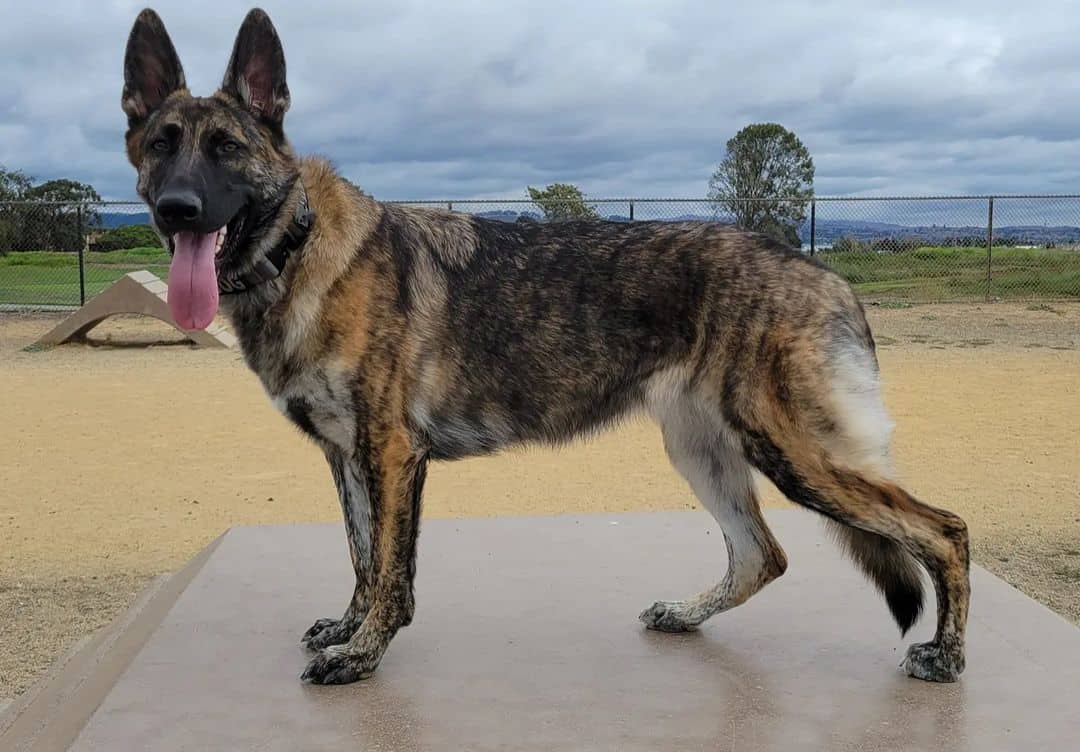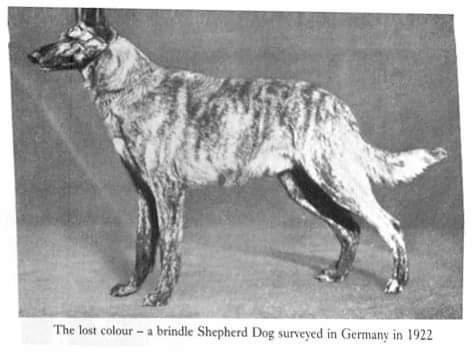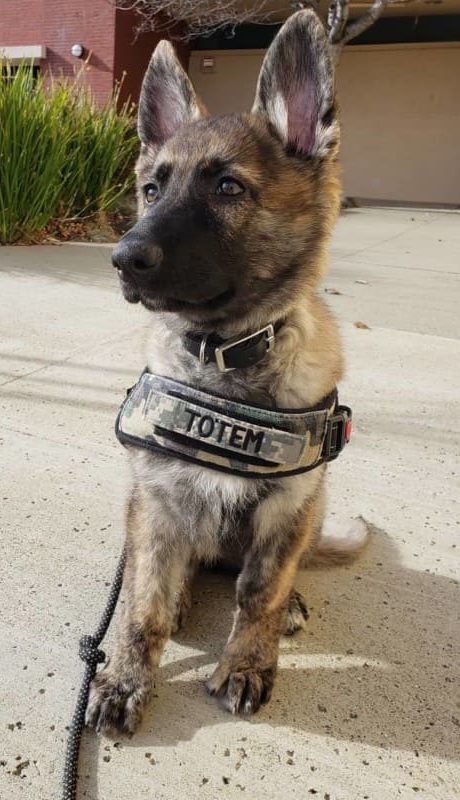A brindle German Shepherd is an exotic German Shepherd featuring a striped appearance ranging from tiger-like to barely visible. The stripe colors and positioning can vary depending on gene mutation, making these dogs look pretty majestic in some instances.
Their rarity adds to speculation, which leads to myths like:
- Brindle German Shepherds are often sick (False)
- Brindle German Shepherds are extinct (False)
- Brindle GSDs can not be shown (False)
- Brindle German Shepherds are expensive (False)
- Brindle GSDs are bad family dogs (False)
Before we get into the dog profile, let’s look at a few corresponding facts.
Brindle German Shepherds:
- Have as much probability of sickness as any type (True)
- Are rare but not extinct (True)
- Can be born in the show bloodline and enter conformation (True)
- Are expensive only when bred intentionally (True)
- Have the same temperament as other German Shepherd colors and patterns (True)
If this inspires your curiosity, below is a deep dive into this breed. Let’s begin!

Brindle German Shepherd: Brief Overview
| Brindle German Shepherd | Breed Characteristics |
|---|---|
| AKC Group | Herding |
| Origin | Germany |
| Type | Companion / Working / Showing |
| Breed Size | Medium to Large |
| Height | 24-26 inches (Males) 22-24 inches (Females) |
| Weight | 66-88 pounds (Males) 49-71 pounds (Females) |
| Temperament | Intelligent, Alert, Brave, Protective, Guard-dog, Athletic, Strong, Confident, Independent, Faithful, High-energy, Aloof, Devoted, Versatile, Territorial |
| Appearance | Powerful, Agile, Proportioned, Long Muzzle, Bushy Tail, Pointy Ears. |
| Lifespan | 10-13 years |
| Health Issues | Bloat (GDV), Hip Dysplasia, Degenerative Myelopathy |
| Coat Colors | Black Brindle, Brindle Tan, Brindle Sable, Brindle Gray |
| Coat Type | Short, Plush (Medium), Double-coated |
| Shedding | Heavy |
| Grooming | Moderate |
| Easy to Train | Yes |
| Exercise Needs | Medium-high |
| Hypoallergenic | No |
| Child Friendly | Yes |
| Pet Friendly | Yes |
| Good for new owners | Yes |
| Cost | $2000+ |
German Shepherd Dogs come in 11 colors registered by the American Kennel Club. Apart from those, specific colors are either unregistered or are considered a coat pattern. One such coat pattern is brindle, a coat pattern best described as striped or marbled.
This pattern is similar to the stripes on a tiger but is more subtle with irregular streaks of color and shapes. These stripes are present on the dog’s coat and legs and appear darker or lighter than the base coat color. Brindle German Shepherds are so rare that there is no singular standard to their actual physical appearance.
However, the most commonly seen coat has blacker markings on a reddish-brown or tan base coat. Their dominant and recessive gene pool decides four different brindle color patterns. They are among the rarest types of German Shepherds and belong to the dominant black gene series. Some people even claim that they are now entirely extinct, which is not the case.
It is unclear where the first brindle German Shepherd originated. But because all current-day purebred varieties got their DNA from Horand von Grafrath, the first registered German Shepherd Dog, brindle GSDs can self-evidently be traced back to him.
Horand sired many pups, and very few pictures (black and white) exist of them. Most experts who have analyzed those photographs believe that at least two of the pups had the brindle color pattern. This makes the brindle coat color pattern one of the originating patterns of the German Shepherd breed.

But how did Horand Von Grafrath, formerly known as Hektor Linksrhein, birth two brindle-colored pups? From a genetics perspective, brindle is one of the three variants of the dominant black gene.
It is also a separate mutation that allows the agouti gene to appear, such as sable, tan points, recessive black, and tricolor. The result causes the agouti color to form streaks or brindling, which explains the presence of a dominant black gene in brindle-colored dogs.
We can trace this color pattern back to Europe when specific colors and color patterns like blue, liver, white, and merle German Shepherds were imported to America.
Max Von Stephanitz (breed founder) wrote: “No good dog is a bad color,”…..but the Society for the German Shepherd Dog (original GSD governing body) decided to eliminate many colors and patterns during wartime in Europe as lighter colored dogs were an easy target. These colors were; blue, liver, white, and the patterns – brindle and blue merle.
The rarity of brindle German Shepherds continues to date mainly because there wasn’t much emphasis on breeding and increasing their number after their partial elimination in Europe.
Learn More About Dog Colour Genetics and Brindle…
Some people also believe that the brindle Dutch Shepherd was bred and registered to the American Kennel Club to create a dog similar to the brindle German Shepherd but still distinguishable.
A brindle GSD is not very different from its counterparts except for its color. Just like other types of German Shepherds, they require lots of physical and mental stimulation. They can be straight-back or sloped back, depending upon their breeding.
Male brindle German Shepherds are usually 24 to 26 inches tall and weigh about 66 to 88 pounds. Females weigh approximately 48 to 70 pounds and are 22 to 24 inches in height. Their typical life span is like that of other German Shepherd varieties – between 10 to 13 years.
They are also highly intelligent like other varieties, and you can quickly train them. Brindle German Shepherds also suffer from specific inheritable health concerns just like all the other types.
What Do Brindle German Shepherds Look Like?
Brindle German Shepherds possess a specific coat pattern of alternating strips of color different from the base color. The exact pattern on each dog depends upon his genetics and is thus variable. Two brindle German Shepherds can even have completely different coat patterns.
Below are the brindle German Shepherd color patterns:
- Black Brindle
- Brindle Tan
- Brindle Sable
- Brindle Gray
- A black brindle German Shepherd is also known as a reverse brindle and possesses recessive genes of solid black, liver, light buff, or blue. They have lighter colored stripes on a darker base coat.
- Brindle-tan German Shepherd Dogs have brindle-colored markings on usually black, blue, isabella, or liver-colored coats.
- Brindle-sable German Shepherds possess the richest brindle color amongst the four types and typically have a darker coat color only on their head and back.
- Brindle-gray German Shepherds, in contrast, have brindle markings that appear either only as brindle points or do not appear at all.
Despite these genetic variations, their coat color is a hot topic for debate and controversies. Some will say that brindle is a non-standard color for German Shepherds and partly due to the close association between brindle coloration and Pit Bulls. Others believe that the brindle gene is genetically unstable.

The American Kennel Club official breed standard does not enlist their coat pattern. Thus this color pattern is always going to be rare amongst mainstream breeders.
The AKC standard for German Shepherds states that: “strong, rich colors are preferred” and “pale, washed-out colors and blues or livers are serious faults.” Pale, washed-out colors refer to black and cream, black and silver, or silver sable. They were inserted into the standard because lighter dogs were easier targets in times of war.
“There is nothing in the AKC or the UKC standard preventing a brindle German Shepherd to be shown, it just hasn’t been done yet.”
World of Dogz
Are Brindle German Shepherds Rare?
Finding brindle German Shepherds is quite a task. German Shepherd history books show that many originating breed colors were eliminated by the German Shepherd Dog Club (also known as SV) in the standardization process of this breed.
Liver, white, brindle, and blue merle colors were chosen to be eradicated because as dogs of war, darker colors and patterns were less of a target. The German Shepherd Dog Club considered the brindle color pattern to be unsuitable in wartime Europe, and thus breeders made no efforts in the following years to increase the numbers.
Today, brindle GSDs can be abandoned in rescue shelters or centers by owners interested in mainstream German Shepherd colors. A few are also left by unethical breeders who misbreed and end up with brindle shepherds with health or temperamental issues. Intentional breeding is very rare as they have been sidelined over the years.
Many see this color pattern as a genetic mutation that makes it even harder for breeders to produce brindle dogs. The brindle gene is one of the three variants of the dominant black gene (the other two are dominant black and non-solid black). Specifics of this gene are mostly a mystery, but it is speculated to result from a spontaneous mutation.
Looking for a brindle German Shepherd is not an easy task, and interested individuals are most likely to return empty-handed. A better option is finding an ethical breeder that breeds healthy brindle-colored German Shepherd puppies.
How Much Do Brindle German Shepherds Cost?
Brindle German Shepherds typically cost around $2,000. But since they are scarce to find, their price can be much higher than anticipated. Similarly, a brindle puppy with papers proving its pedigree, line, breeding history, and running title will have a much higher price.
It is evident that prices mainly depend upon breeders. Because of their high demand and low availability, some unscrupulous breeders often breed and raise brindle pups inadequately to make money quickly. This takes a toll on their health and makes them prone to illnesses.
The official coat colors listed in the German Shepherd official AKC breeding standard are black, black and tan, black and cream, black and red, black and silver, blue, white, liver, grey, and sable. However, the German Shepherd Dog Club of America (who has control over the written standard within the AKC), does not want to list colors and patterns separately.
Exotic patterns such as brindle are frowned upon by many breeders and some dog clubs, which reduces their popularity. However, a few ethical breeders focus their breeding programs on the development of such rare coat-color patterned dogs. You can find such breeders, but you may have to pay whatever price they charge.
If you are looking to take a brindle German Shepherd in as a pet, adopting is a good option as adoption fees are much lower. However, you’ll find a specimen at a shelter only if you’re lucky.
Are Brindle German Shepherds Good Family Dogs?
Brindle German Shepherds are good family dogs. They get along with children and other pets and are incredibly intelligent and thus highly trainable. They also make good guard dogs as they innately have protective instincts. Their temperament traits are the same as all other GSD types.
These dogs are highly versatile and have an uncanny ability to learn new tricks. Their easy-going temperament makes them easier to train than other breeds. They are eager to learn and, if socialized and trained correctly, make great companions. They are somewhat aloof to strangers, and some may even be fearful of new people or other dogs or animals.
You can prevent this by socializing them early to become familiar with new people and smells and sounds. A lack of socialization can make them aggressive and view other animals and people as threats, leading to destructive behavior. In contrast, they grow up to be calm and well-balanced and behaved dogs when trained well.
“Training is usually more effective if you develop a common language with your dog, where you establish yourself as the one in charge.”
World of Dogz
Brindle German Shepherds are very obedient and friendly dogs. Since they require appropriate mental and physical stimulation, you can quickly devise exercises or training routines that you both can follow, such as jogging, running at the beach, hiking in the woods, fetching a ball, or playing certain sports.
Exercising along with your dog develops a friendly bond of trust with him. Brindle GSDs are very loyal dogs, and once this bond is established, it can never be severed. Apart from being good family pets, German Shepherds are also great for agility training, lure coursing, flyball, tracking competitions, Schutzhund training, and search-and-rescue work.
The brindle German Shepherd is also known as a mouthy breed because they use their mouths due to their herding heritage. Therefore, it is normal for them to chew on anything that fits in their mouth.
But you do not have to allow it as you can train them to channel their instincts appropriately and safely. They are also very social and would be the happiest when with family. These loving and affectionate creatures will put their own lives at risk to protect their loved ones.
Some people believe that their coat color correlates with bad temperament, thereby making them unfit for families. That is untrue because the brindle color does not affect the dog’s temperament or health, just like any other recessive or non-standard color variation.
The Center for Animal Genetics says that their color is a genetic factor determined by color pattern genes and does not impact their obedience, intelligence, or even working ability. They possess traits and a temperament comparable to other standard colored German Shepherds.

Pros of Brindle German Shepherds
Unique Appearance:
Brindle German Shepherds have a unique and majestic appearance that makes them stand out from other types. They have a wolf-like appearance and are relatively sturdy and well-built with a proportioned body, making them visually appealing. They also possess a double coat, a bushy tail, and erect ears, making them look intimidating yet cuddly.
Versatile Dogs:
Brindle German Shepherds are versatile dogs with incredible intelligence, loyalty, and bravery and are among the top obedience competitors. They can be trained through consistent reinforcement-based training and mentally and physically stimulating exercises to excel at various activities.
They possess an incredible cognitive, physical, and emotional capacity and are great at police work, therapy, scent detection, agility, and service work. The German Shepherd breed ranks third in intelligence globally.
Very Protective:
Brindle German Shepherds have an alert nature and are incredibly loyal to their guardians, and make great protective dogs. The behavior of dogs usually depends on the education and environment they are subjected to. Consequently, you can train them to be friendly and fierce.
Highly Active and Energetic:
These dogs thrive on regular exercise and possess medium to high energy drive. Not giving them enough mental and physical stimulation can adversely affect their health and behavior.
If you are not an active person, they are not the right fit for you. But if you lead an active lifestyle, they can be your best companion and even motivate you to exercise or burn those extra calories.
They Can Quickly Become Your Best Friend:
Brindle German Shepherds know how to be affectionate without being clingy. If you develop a strong bond with them, they can quickly become your best friend and would love you no matter what. They may look intimidating on the outside but are deeply caring dogs on the inside and would always put you first.
Cons of Brindle German Shepherds
Have Heritable Health Concerns:
The Orthopaedic Foundation for Animals reports that all German Shepherds are prone to several heritable health concerns, such as hip and elbow dysplasia, degenerative myelopathy, and von Willebrand disease, to name but a few.
Since they are not bred according to specific breeding standards, it is widespread for these dogs to develop such conditions. It is essential to make sure that your dog has health-tested parents before adopting.
Hard To Find and Expensive:
Brindle German Shepherds are so rare that they are almost impossible to find. Their rarity adds to their price as well. Finding healthy brindle dogs in shelters and rescue centers can be even more challenging than looking for serious breeders.
Show Dogs May be Marked Down:
Brindle German Shepherds can participate in dog shows held by the American Kennel Club and similar bodies such as the United Kennel Club. There is nothing in the breed standard that disqualifies their exotic coat color pattern from being show dogs.
The confusion lies in that no brindles have yet entered the show ring as it is presumed by many owners that they will be marked down by the judges.
Can Become Greedy:
Although they have well-balanced behavior, they can still overeat and even become somewhat gluttonous. Their eating habits need to be monitored carefully to manage their weight.
You may also need to eradicate bad eating habits to prevent them from becoming fussy eaters. You should also portion their daily food intake into two or three meals to prevent bloat (GDV).
Should You Get a Brindle German Shepherd?
The father of the German Shepherd breed, Max von Stephanitz himself, says that “No good dog is a bad color.” Although mystique surrounds brindle German Shepherds, they are incredible dogs and possess outstanding mental and physical traits.
However, they should not be adopted simply for their aesthetic appeal or their rarity. You should only get a pup if you treat it like a family member and companion and raise it according to their needs.





